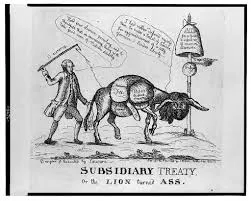Lord Wellesley Subsidiary Alliance:
The Subsidiary Alliance was a diplomatic strategy employed by Lord Wellesley, who served as the Governor-General of India from 1798 to 1805. This strategy was a significant part of British expansionist policies in India during the early 19th century. The Subsidiary Alliance aimed at extending British influence and control over princely states without directly annexing them.
Key features of the Subsidiary Alliance:
1. Military Protection:
Under the Subsidiary Alliance, the princely state had to accept British military protection. In return, the British stationed their troops within the state, ostensibly to protect it from external threats.
 |
| Subsidiary treaty |
2. No Foreign Relations:
Princely states entering into a Subsidiary Alliance were required to surrender their foreign relations to the British East India Company. They were not allowed to enter into treaties or alliances with other powers without British approval.
3. Maintenance of Troops:
The cost of maintaining the British troops stationed in the princely state was the responsibility of the princely ruler. This often imposed a financial burden on the state.
4. Dependence on British Support:
The ruler of the princely state had to acknowledge British supremacy and agree not to maintain any armed forces other than those under British control. This made the princely state dependent on British support for its security.
5. Controlled Administration:
Though the ruler continued to govern internally, the British influenced the administration, and British residents were appointed to guide and advise the ruler. The British Resident often held significant influence over the state's affairs.
6. Financial Obligations:
The princely state had to pay for the maintenance of British troops, which often led to financial strain. The British also imposed heavy fines or financial penalties for any perceived breach of the alliance.
The Subsidiary Alliance was an effective tool for the British to establish dominance without the need for direct annexation. Several princely states, including Hyderabad, Awadh, and Mysore, were brought under the Subsidiary Alliance. Lord Wellesley's implementation of this policy significantly expanded British control over Indian territories and set the stage for further annexations and consolidation of power.